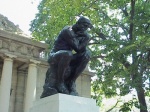
Rumor has it that as a species — Homo sapiens — we originated in Africa and migrated all over the globe. On a daily basis each of us requires some essential inputs like clean air, water, food, clothing, rest and shelter. See Viewing the Body as a Complex Machine. Shelter provides protection from the elements like heat and cold, the wind, rain, etc, and from daily and seasonal variation and their extremes. The nature of the protection required depended upon where we were living and on the materials that were available locally as well as the skills and tools of our ancestors. That is where our creativity as a species came into play. Using the resources that were available locally and their imagination, our ancestors created shelters to protect themselves from the elements. They were all different and beautiful. They included: Cave dwellings, Teepees, Adobes, Sod huts, Thatch houses, Igloos, and Log cabins. Many different structures evolved. Those are just some of them. Aren’t they beautiful, artistic and creative? For a better understanding about what we would like to know about each of these shelters as works of art see Seeing Some Shelters and Clothing as Fine Art and Fine Craft. Continue reading “Shelter”
